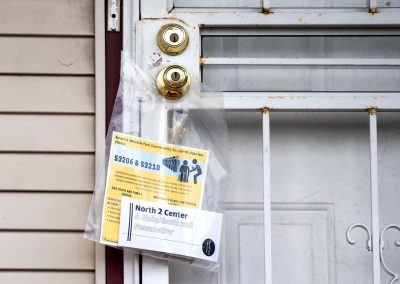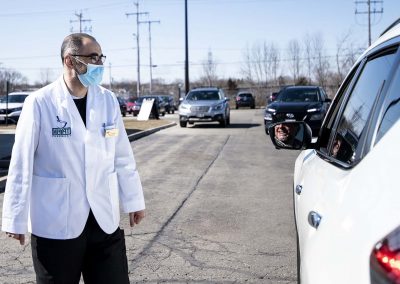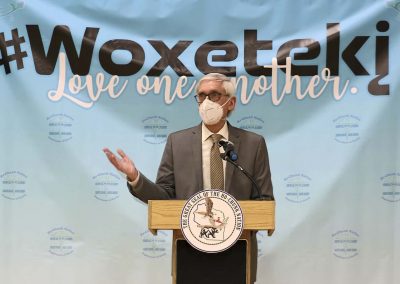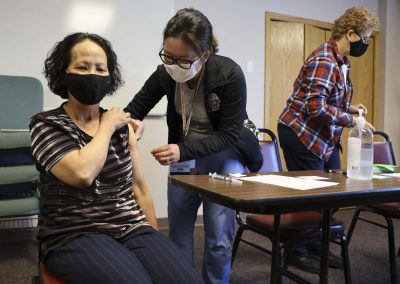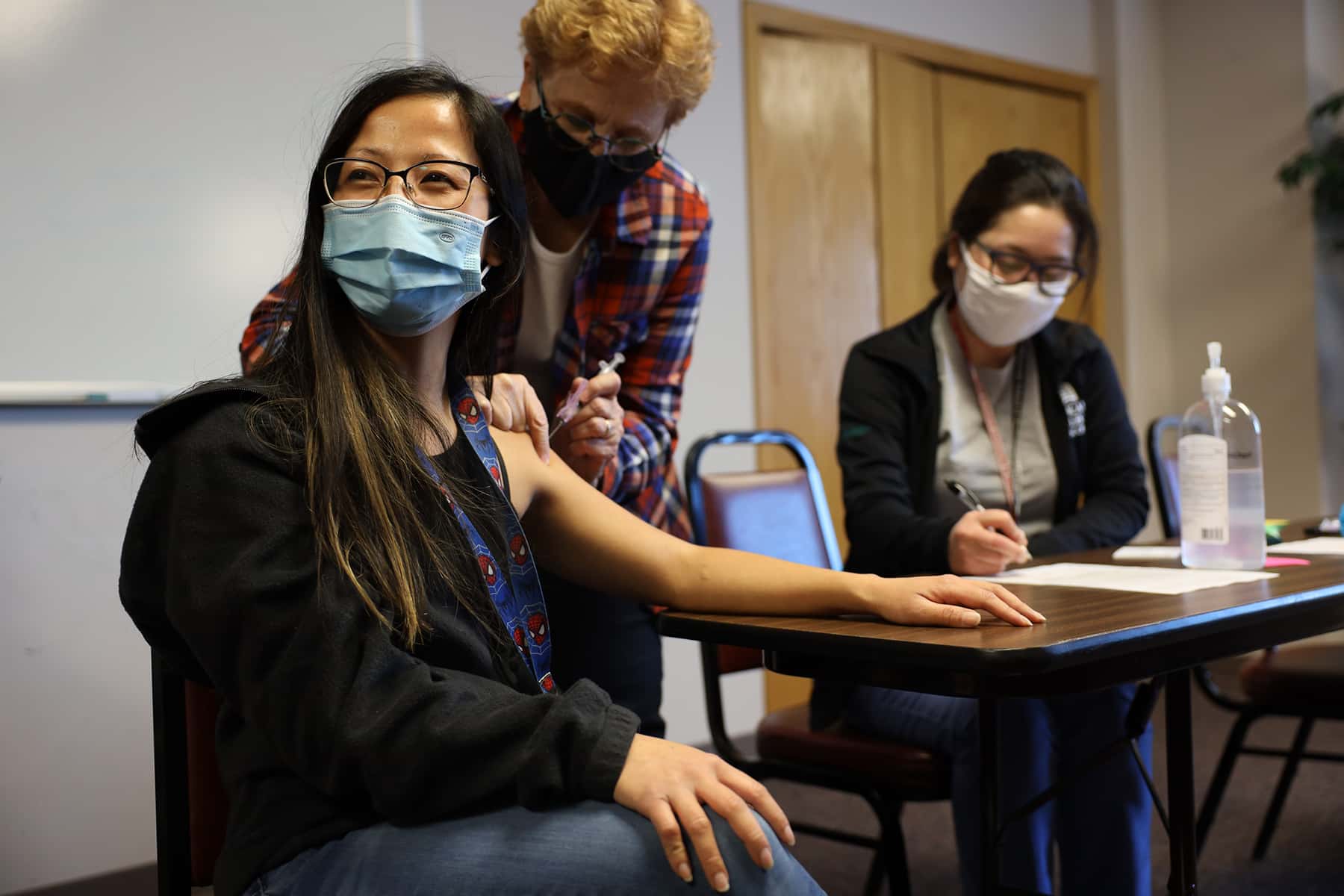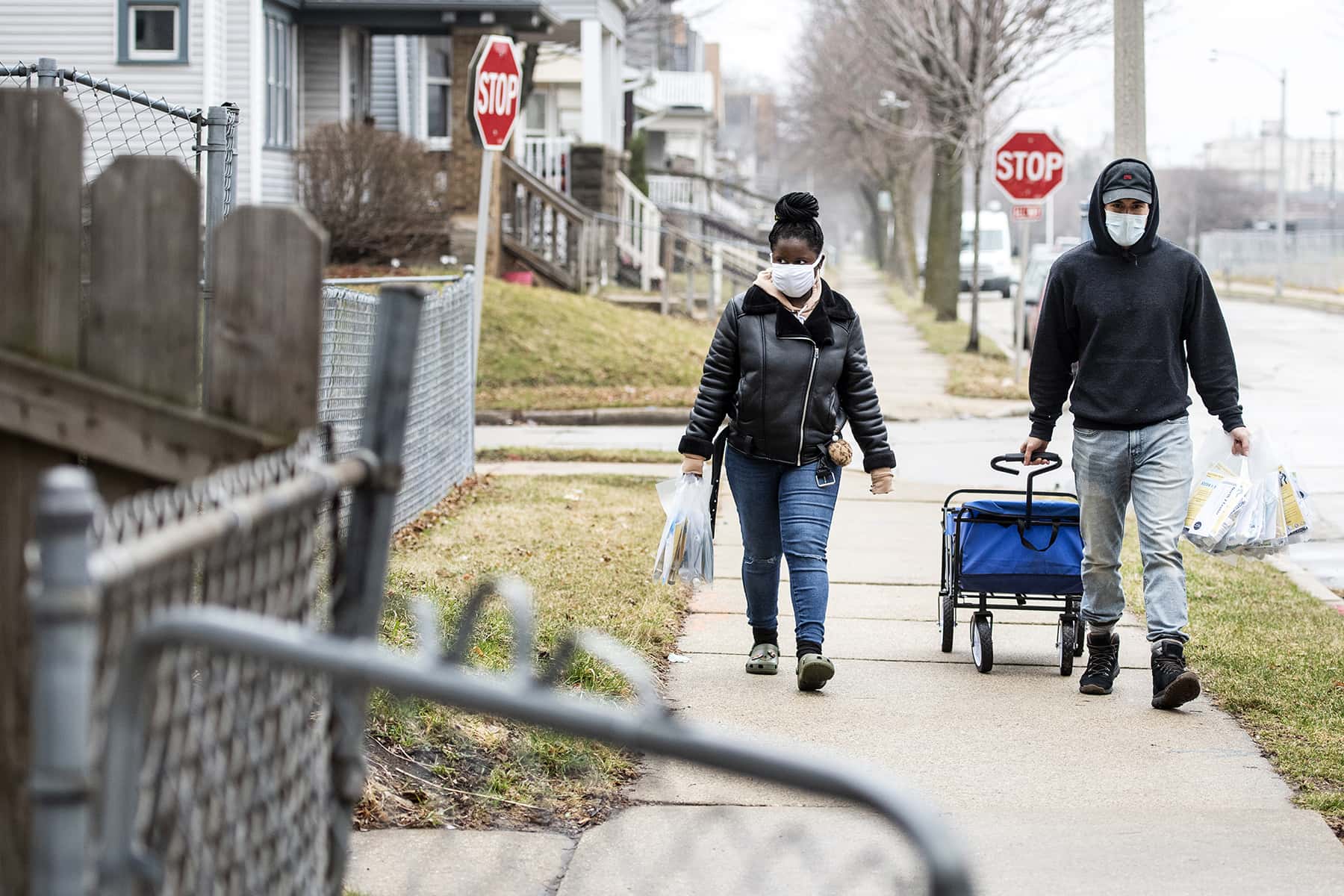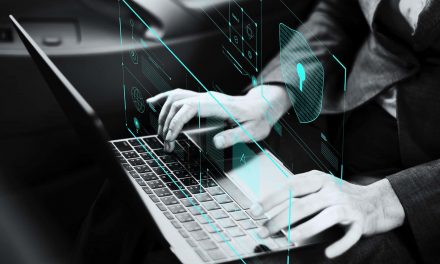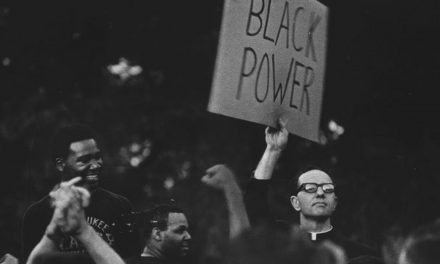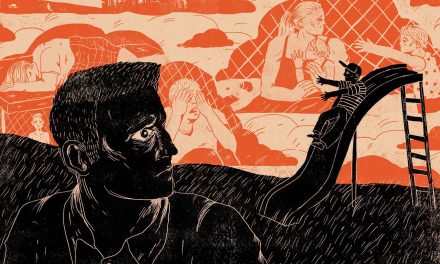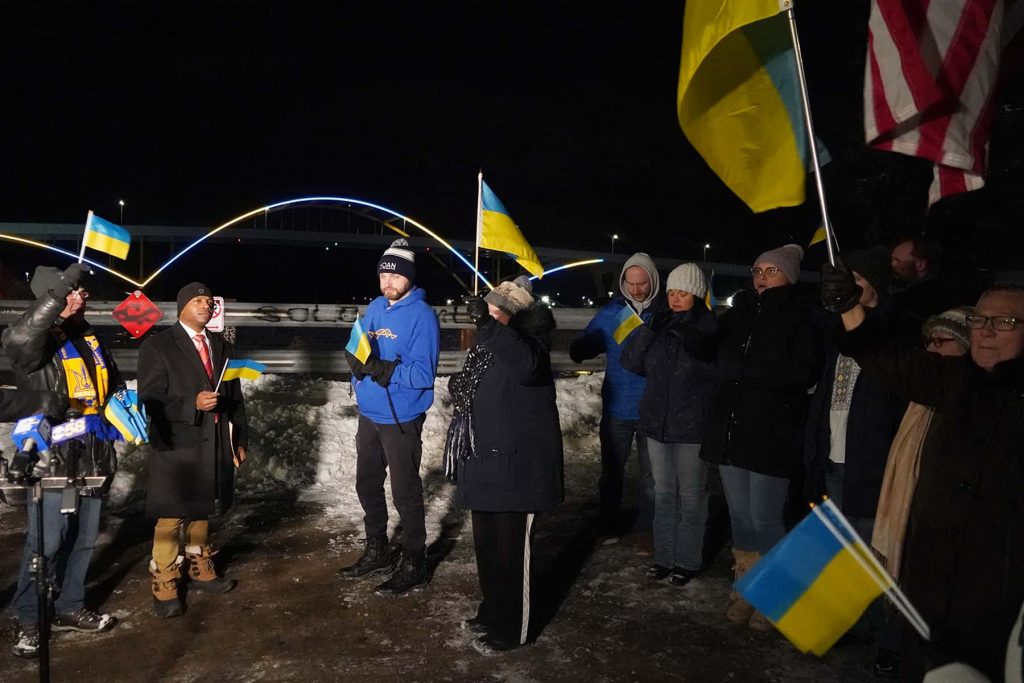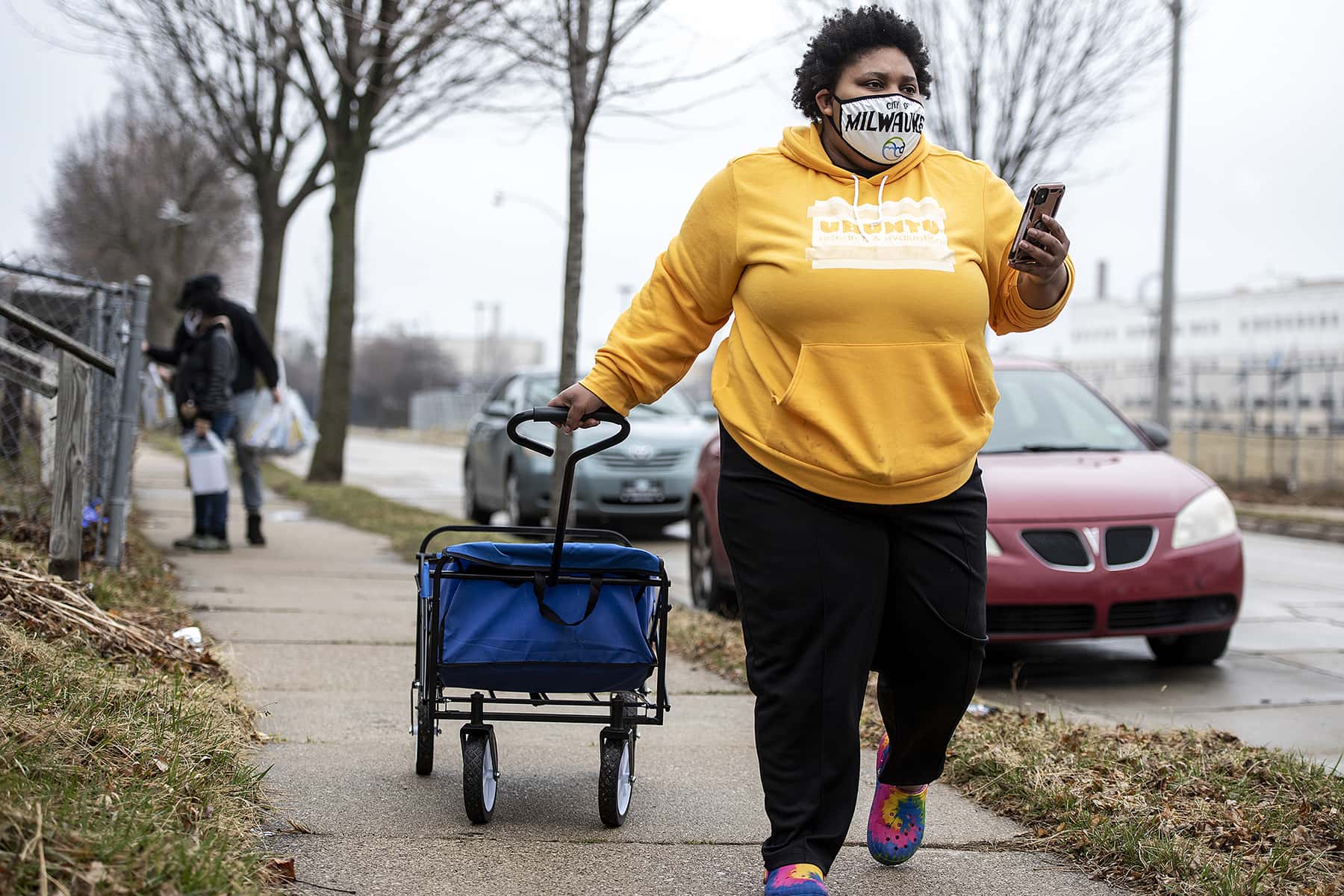
Community groups have found success through partnerships, deep listening, and meeting people where they are. They are lessons that transcend vaccination campaigns.
Barbara felt ecstatic in January when a Wisconsin Department of Health Services letter confirmed that she and her parents were eligible for COVID-19 vaccinations. The 28-year-old education student lives with her parents in Milwaukee. All three share caretaking duties for Barbara’s young child, who is on the autism spectrum. That unpaid work qualifies them as frontline health care personnel in Wisconsin’s vaccine rollout.
Barbara’s last name has been withheld to avoid repercussions for her parents, who are living in the country without legal authorization. The family arrived in Wisconsin from Mexico about two decades ago. Barbara is currently protected from deportation under the federal Deferred Action for Childhood Arrivals (DACA) policy, which grants some rights to eligible immigrants who came to the United States as children.
Barbara shouldered more caretaking duties during the pandemic because her parents work outside of the home, and they feared exposing the child to the coronavirus. Vaccinations would offer peace of mind and make everyone’s life a little easier. Booking three appointments at a Milwaukee Walgreens went smoothly enough.
But Barbara didn’t anticipate the obstacles once they showed up. Pharmacy staff turned away her parents because their IDs were expired, she said. Barbara said she presented two current, state-issued IDs but was asked for additional proof of residency. The pharmacy gave her a 45-minute deadline to return after fetching it from home, she said. The family left and didn’t come back. It is just one example of what some members of racial and ethnic groups in Wisconsin say are barriers to getting vaccinated among people hardest hit by the pandemic.
Shots at last
The family eventually received shots through the Milwaukee Health Department, where a family member works. But not until a month later.
“I know we’re not the only ones who have gone through something like this,” Barbara said, referring to the broader Latino community. “A lot of us want to get vaccinated. But we’re not given the option to get vaccinated. … it’s very challenging, especially for the undocumented community.”
Walgreens would not comment on Barbara’s experience unless she signed a medical privacy waiver, a corporate spokesperson said in an emailed statement. The pharmacy asks for identification at the appointment to match the person receiving the vaccine to the person who booked it online, according to the statement.
“We also ask them to confirm their attestation again in store to reconfirm they are eligible to receive a vaccine. Unless specifically required by a jurisdiction, our policy is to not turn away individuals who do not produce an ID,” the statement said. “Neither a state-issued ID nor U.S. citizenship is a requirement for a vaccine. We are reiterating this policy with our 40,000+ pharmacy team members.”
Vaccinations hard to find for some
Public health leaders have called Wisconsin a national leader for quickly and widely delivering shots to residents. But access remains far from even among Wisconsinites. The state’s racial, ethnic and other minority groups face major barriers to inoculation — just as those groups suffer a disproportionate share of COVID-19 infections, hospitalizations and deaths. A March study of 48 states ranked Wisconsin 32 in delivering shots to highly vulnerable communities. Interviews with Barbara and others illustrate how barriers are fueling disparities in the state’s vaccination rollout.
Sheng Khang of Wausau, who is Hmong, sees barriers in the form of “white-culture-based” security questions she answered in a health records portal while booking an appointment for her mother, who immigrated to Wisconsin 26 years ago. The online portal asked for the patient’s astrological sign.
“I don’t think my mom would know what her astrological sign is. She would be confused,” Khang said.
Melody McCurtis sees a range of barriers for residents in the Metcalfe Park neighborhood on Milwaukee’s Black-majority North Side. Those include a lack of internet access, time and transportation — resources that more privileged vaccine hunters have used to find appointments during times of high vaccine demand.
Wisconsin officials anticipated some challenges early in their vaccination campaign. DHS in April awarded $6.2 million in grants to promote vaccine access in underserved communities. But DHS data reveal that stark disparities persist: Only 12% of Black residents have received at least one vaccine dose as of April 1, compared to 29% of white residents, 20% of American Indian residents and 19% of Asian residents. Meanwhile, only 14% of residents identifying as Hispanic have received a dose, compared to 30% who are non-Hispanic.
Aiming to understand what works, nearly a dozen people working to bring vaccines into underserved communities were interviewed. The barriers in each community vary, but the solutions illustrate common themes, including the power of partnerships, deep listening and meeting people where they are — sometimes through low-tech methods, such as door knocking and even organizing sporting events. The diverse experiences offer lessons for tackling disparities across the health care system.
‘Our ZIP code has been left out’
Aiming to reach Black and brown-majority neighborhoods in deeply segregated Milwaukee, state and local officials in March broadened vaccine eligibility to all residents 18 years and older who live in 10 city ZIP codes. Not on that list: 53210, home to Metcalfe Park.
“Our ZIP code has been left out,” said McCurtis, deputy director of the nonprofit Metcalfe Park Community Bridges, “even though we know that when COVID first broke out, 53210 had some of the the most cases, the most deaths and people were getting sick and dying from this virus.”
Under the plan by Governor Tony Evers, Wisconsin expands eligibility to all residents 16 and older beginning April 5. McCurtis would have drawn up rules differently early in the state’s vaccine rollout — prioritizing all people experiencing homelessness, seniors and people of color. But it wasn’t up to her, so she worked to improve access within her neighborhood. Her group worked with the city health department and three Milwaukee nonprofits to launch vaccination clinics open to residents 16 and older who live in the Metcalfe Park and Amani neighborhoods.
The coalition, funded by The Northwestern Mutual Foundation, is planning eight vaccination events through early June. COA Youth and Family Centers and the Wisconsin Black Historical Society are hosting the clinics. Those familiar spaces offer easy access to neighborhood residents, McCurtis noted, and appointments are open to walk-ups only — to decrease the likelihood that digitally connected vaccine hunters living elsewhere will gobble up slots.
“We’re hopeful that folks are going to come out and get the vaccine now that it’s in a walkable distance. It’s right in their neighborhood,” McCurtis said.
That requires spreading the word. McCurtis and other volunteers are circulating information about the events and vaccines themselves. They are also closely listening to their neighbors.
Earlier listening sessions revealed less trust in the Johnson & Johnson vaccine — hesitancy popping up in various communities nationwide. Clinical trials have shown the company’s single-dose vaccine to be safe and effective. But at one glance, the vaccine might appear less effective at preventing COVID-19 illnesses, compared to the Moderna and Pfizer vaccines, whose trials produced a higher efficacy rate. Experts caution that Johnson & Johnson performed its tests later in the pandemic as coronavirus variants emerged, making rate comparisons apples-to-oranges.
Even so, McCurtis knows that perception matters, especially in communities that have reason to distrust an American health care system with a racist track record. So the coalition’s walk-in clinics will deliver only the Pfizer vaccine — to reduce any hesitancy.
“We don’t even want to waste time on trying to talk folks into something that they just don’t want to do,” McCurtis said.
As interest grows in the community clinics, McCurtis said, “We’re seeing the effects of what access, real outreach and commitment does to a community that has been oppressed and almost left on the back burner for almost a year now.”
Offering comfort and familiarity
Madison, Wisconsin’s Hmong community is seeing similar success with vaccination events. The Hmong Institute, a nonprofit, hosted two such events in March and plans more. Life Center Madison is hosting the events, providing a familiar backdrop for residents who previously attended Hmoob Kaj Siab, The Hmong Institute’s culturally and linguistically accessible mental health program for elders, which paused during the pandemic.
The familiarity is key to encouraging shots among Hmong elders, some of whom faced trauma around vaccinations before arriving in Wisconsin as refugees from Laos, Vietnam and neighboring countries following the Vietnam War, said Peng Her, CEO of The Hmong Institute.
In some cases, the military in Laos forced mass vaccinations upon villages. Other residents may have received poor treatment from disdainful Western doctors at refugee camps decades ago, Her said.
“There was a lot of distrust built back then,” he said. “Fast forward to now when even the testing site at (Madison’s) Alliant Energy Center — the National Guard was there to help. That helps trigger a lot of the things that they witnessed and saw back in Laos.”
Vaccination site staff speak in Hmong, and the Hmong Medical Association offers information about the vaccine and possible side effects through a video playing in a waiting room. Since some residents lack internet access, The Hmong Institute uses word of mouth and other outreach channels. Most of the 49 people vaccinated at the first event, on March 9, previously participated in programs such as Hmoob Kaj Siab, Her said. A March 23 event vaccinated 80 residents, and the institute plans to vaccinate 200 more at the next event.
‘Why do you want to help me?’
In Marathon County, the COVID-19 Hmong and Hispanic Communication Network (H2N) is spreading information and helping to book vaccine appointments through extensive on-the-ground outreach.
Khang, who booked her mother’s vaccine appointment in Wausau, serves as a Hmong community coordinator for the network, a joint project of the Wisconsin Institute for Public Policy and Service and the Medical College of Wisconsin-Central Wisconsin. Khang said her team reaches residents in a variety of ways, including through a Hmong-language podcast and a booth at the Wausau World Market, where her colleagues can chat up community members, hand out materials and schedule appointments.
The Wausau-based Hmong American Center is also a crucial partner, Khang said, since struggling residents have relied on it during the pandemic for information on everything from food, rental assistance — and now vaccine logistics. Outreach to Marathon County’s Hispanic communities looks somewhat different, said Tony Gonzalez, a Hispanic community coordinator for H2N. Their homes are spread out across rural countryside — often without internet access — and they lack a centralized community center, Gonzalez said.
So Gonzalez meets residents where they are. He runs a soccer league, where he can circulate vaccine information to some of the 300-plus people who participate each Sunday. Gonzalez also occasionally appears as a guest on El Premerito, a popular local Spanish-language podcast.
Isis Vidal and Norma Castro, two network liaisons, perform additional outreach, delivering food door-to-door and sharing information about a variety of rent relief and other topics. DHS funding last year allowed Vidal and Castro to spread information about flu shots, and now they are focusing on COVID-19 vaccines. Equipped with training, the women answer questions such as how much vaccines cost (nothing) and what documents are needed. They also spend time building trust, Vidal said, which strengthens their work.
“(Residents) are wondering, ‘Why are you here?’ ” Vidal said in an interview interpreted by Mariana Savela, another H2N community coordinator. “ ‘Why do you want to help me? What do you want from me? And why are you really interested for me to get vaccinated?’ ”
The team’s earlier engagement around flu vaccines yielded lessons for the COVID-19 campaign, Savela said. But they’ve also faced unique limitations. Whereas the team found familiar, accessible churches to host flu vaccine clinics, the intense cold storage requirements of the Pfizer and Moderna vaccines eliminated that option. Johnson & Johnson’s vaccine is easier to store, but it carries a moral stigma in these predominantly Catholic communities, Savela said. Some Catholic leaders have raised concerns about the role of cells derived from decades-old fetal tissue in the vaccine’s development.
Still, Savela’s team has notched successes. Those include working with an Abbotsford Pick ‘n Save pharmacy to reserve 100 doses for Latino residents. Spanish-speaking pharmacy employees called residents to schedule appointments over the phone, overcoming the obstacle of English-only scheduling websites. H2N community liaisons supplied a contact list.
The vaccination campaign could get a bigger boost on later this week when a community-based clinic opens in Wausau, in partnership with DHS. The site is slated to deliver as many as 1,000 doses per day.
Forging partnerships
Elsewhere, partnerships have boosted access. When a Sixteenth Street Community Health Centers clinic on Milwaukee’s Latino-majority South Side struggled to find vaccine storage, it partnered with Ascension to begin delivering shots. An additional partnership with Walgreens allowed the clinic to host events capable of vaccinating 800 people in a day, according to Itza Vargas, a nursing director for the clinic.
The clinic so far has delivered shots to more than 4,100 people, 77% of them saying they primarily speak a language other than English. Vargas attributed the success to trust built over the years.
“It’s great to be able to reach the underserved in the community where we’re seeing that COVID was so prevalent,” Vargas said.
The Aging and Disability Resource Center of Central Wisconsin will soon aid some of the roughly 85,000 elderly and disabled residents they serve in Langlade, Lincoln, Marathon and Wood counties. With DHS grant funding and other federal dollars, the center will hire bilingual staff to work phones and travel to register residents for vaccines, said Jonette Arms, the center’s executive director.
The center has already sent vaccine information to residents through the Meals on Wheels program, and it partners closely with local public health departments and other groups. The new funding will allow it to schedule appointments and, if logistics allow, offer in-home shots for the homebound. It’s one of several projects statewide to reach such residents.
Said Arms: “We’re going to do as much outreach as we can, as much advertising as we can. And we’re hoping that people will begin calling us and we can get them registered.”
Bram Sable-Smith
Coburn Dukehart and Angela Major
The nonprofit Wisconsin Center for Investigative Journalism collaborates with Wisconsin Public Radio, Wisconsin Public Television, other news media and the UW-Madison School of Journalism and Mass Communication. All works created, published, posted or disseminated by the Center do not necessarily reflect the views or opinions of UW-Madison or any of its affiliates.

